Cannabis legislation in Canada
- In 2018, Canada federally legalized the recreational use of cannabis among adults, with minimum age requirements varying by province.
- "After a steady decrease in patterns of cannabis use among youth over several years, it appears that there has been a gradual increase in cannabis use among youth following the start of discourse around cannabis legalization, with some populations of youth being at greater risk. " (Zuckermann et al, 2019)
Trends in cannabis use
Did you know?
- Among students participating in COMPASS in 2018/19, 26% have used cannabis at least once in their lifetime, and 13% report using at least monthly.
- Cannabis use increases with grade and spending money, and use is more common among males and indigenous students.
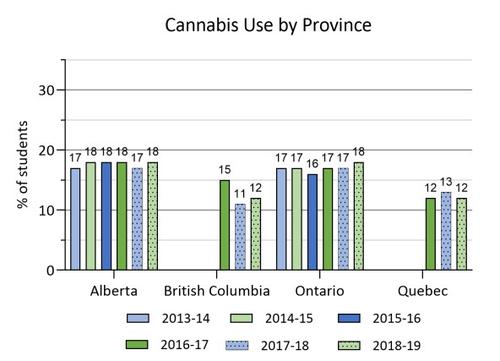
This figure describes the percent of students who use cannabis in Alberta and Ontario from 2013/14 to 2018/19 and British Columbia and Quebec from 2016/17 to 2018/19; use has largely remained constant with slight changes year to year, except British Columbia which has decreased.
Cannabis use is defined as any use in the past 30 days
Source: 2013-14 to 2018-19 COMPASS schools
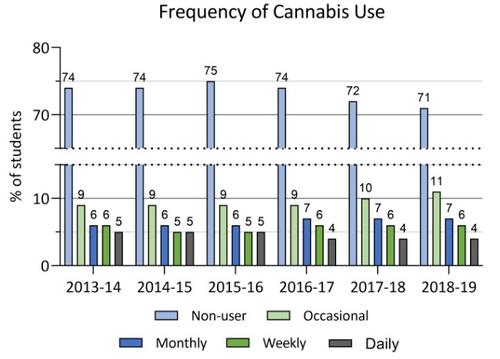
This figure describes frequency of cannabis use among students between 2013/14 and 2018/19, categorized by daily, weekly, monthly, occasional, and non-use; over this time, non-use has decreased, occasional and monthly use has increased, and weekly and daily use has remained constant.
Source: 2013-14 to 2018-19 Ontario COMPASS schools
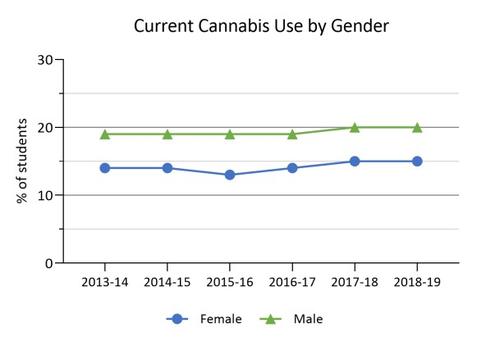
This figure describes the percent of male and female students who currently use cannabis between 2013/14 and2018/19; use has increased in both genders, and female use has remained consistently lower than male use.
Current cannabis use is defined as any use in the past 30 days.
Source: 2013-14 to 2018-19 COMPASS Ontario Schools
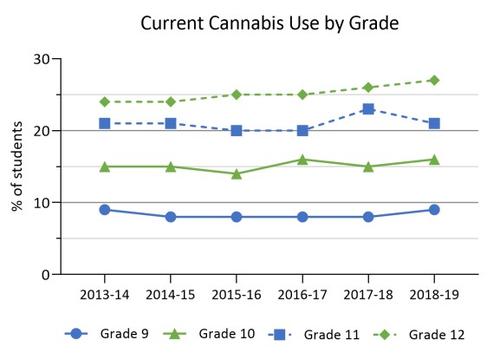
This figure describes the percent of students in grades 9, 10, 11, and 12 who currently use cannabis between 2013/14 and 2018/19; cannabis use increases by grade, and over time remains steady across most grades, however grade 10 and 12 show slight increases.
Source: 2013-14 to 2018-19 COMPASS Ontario Schools
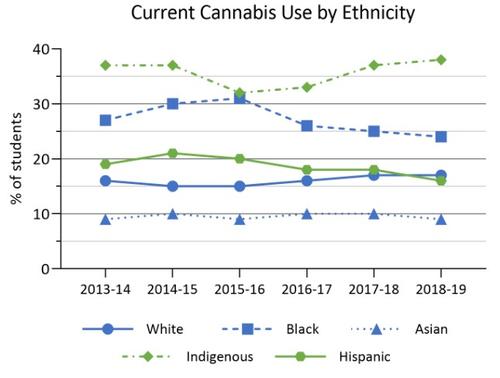
This figure depicts the use of cannabis between 2013/14 and 2018/19 among White, Black, Asian, Indigenous, and Hispanic students; Indigenous students have the highest frequency of use, followed by Black, White, Hispanic and Asian students. Use among Black and Hispanic students has decreased, use among Indigenous and Asian students has remained the same, and use among White students has increased over this time.
Source: 2013-14 to 2018-19 COMPASS Ontario Schools
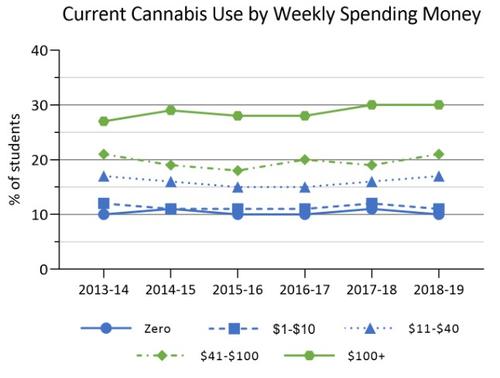
This figure describes the percent of students who currently use cannabis based on weekly amounts of spending money between 2013/14 and 2018/19; students with $100+ use the most cannabis, followed by $41-$100, $11-$40, $1-$10, and zero dollars of weekly spending money. Use among all groups has shown slight year to year changes but remain steady overall, except an increase in use among students with $100+ weekly spending money.
Source: 2013-14 to 2018-19 COMPASS Ontario Schools
Cannabis use and mental health
- Students who use cannabis more commonly report symptoms of depression and anxiety and these symptoms increase as cannabis is used more frequently. (Butler et al, 2019)
- The presence of depressive symptoms, and poorer emotional regulation skills were associated with higher rates of cannabis use.(Romano et al, 2019)
- Students who report greater psychosocial wellbeing (e.g. flourishing) are less likely to use cannabis or use at higher frequencies. (Romano et al, 2019; Butler er al., 2019)
Other health behaviours associated with cannabis use
- Polysubstance use, inclusive of cannabis, vaping and alcohol, was reported by 13.5% of Ontario and Alberta students. (Zuckermann et al, 2019)
- Escalation of cannabis use throughout high school was associated with being male, vaping, and low math marks. (Zuckermann et al, 2018)
- Students that engage in healthier behaviours (e.g., meeting screen time and sleep guidelines) are less likely to use cannabis. (Romano et al, 2019)
- Binge drinking, cigarette use, vaping, and opioid use were all associated with higher rates of cannabis use. (Romano et al, 2019)
Modes of use among students who use cannabis in 2018/19
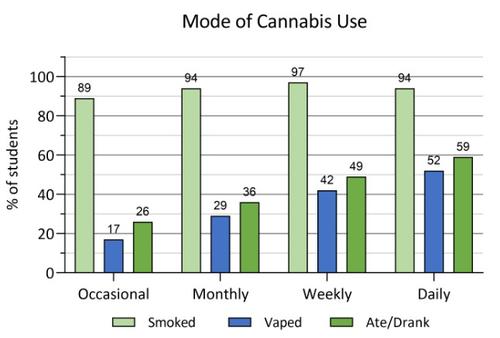
This figure describes the mode of cannabis use among students who use cannabis on an occasional, monthly, weekly, and daily basis, categorized by smoking, vaping, and eating or drinking cannabis. Smoking is consistently the most frequent mode of use, followed by eating or drinking then vaping. The percent of students who consume in any way increases with more frequent use.
Values do not add up to 100% as students could select more than one response.
Cannabis and school outcomes
- Improving school connectedness is protective against the frequency of cannabis use among students. (Weatherson et al, 2018)
- Students who used cannabis were less likely to attend class regularly, complete their homework, and achieve and value high marks, relative to their peers who abstained from using cannabis. (Patte et al, 2017; Williams et al, 2019)